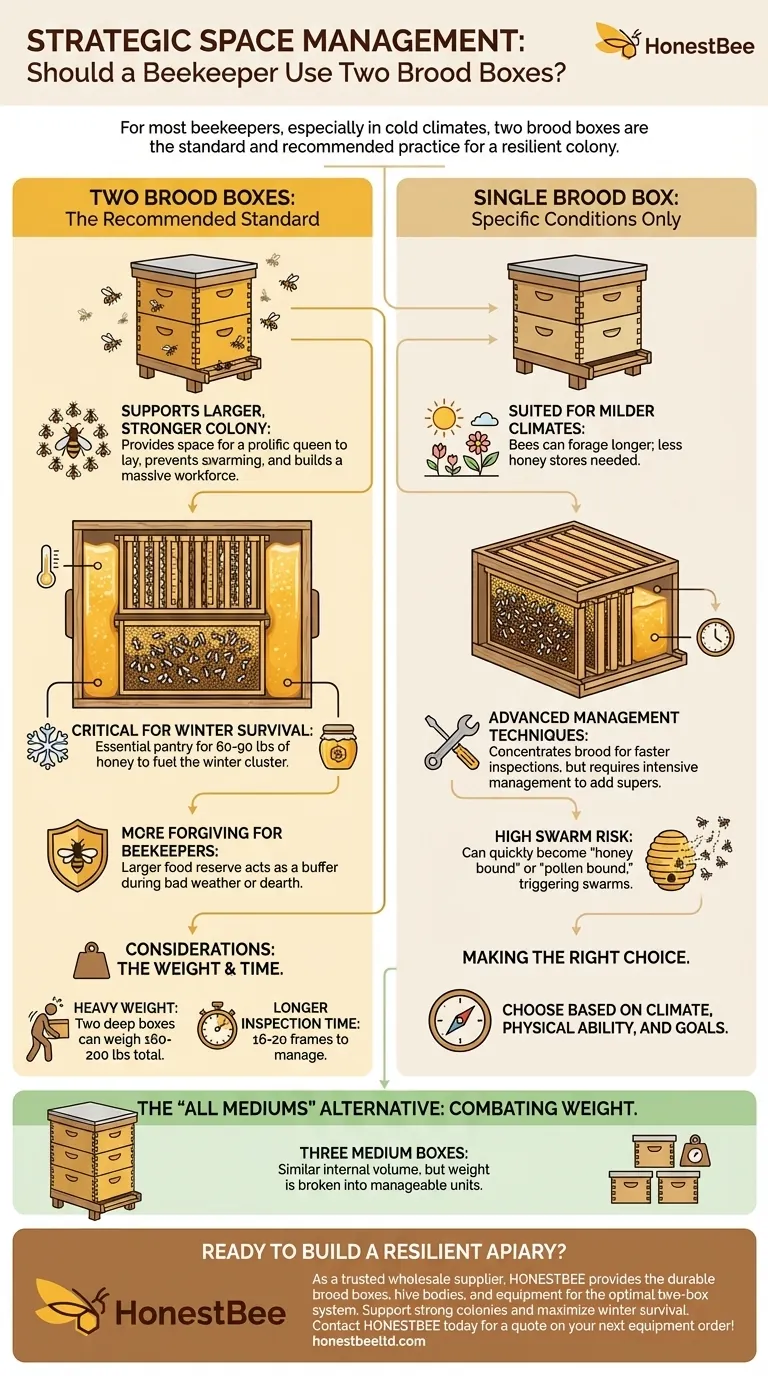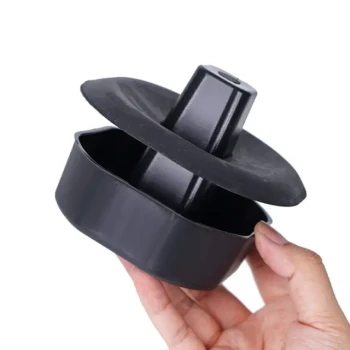For most beekeepers, especially those in regions with cold winters, using two brood boxes is the standard and recommended practice. This configuration provides the necessary space for the queen to lay a robust population of bees while also allowing the colony to store enough honey and pollen to survive the winter.
The decision between one or two brood boxes is not a matter of preference but a strategic choice about space management. For the vast majority of beekeepers, a two-box system provides a crucial buffer against starvation and creates a stronger, more resilient colony.

The Role of the Brood Chamber
To understand the one-vs-two box debate, you must first understand the purpose of the brood chamber, also known as the hive body. It serves two critical, simultaneous functions.
The Colony's Nursery
The primary function of the brood chamber is to house the "brood," which includes the eggs, larvae, and pupae. The queen requires a large, uninterrupted area of honeycomb to continuously lay eggs, ensuring the colony's population can grow and replace older bees.
The Colony's Pantry
Surrounding the brood nest, the bees store honey and pollen. This is their immediate food source, essential for feeding the developing larvae and the adult bees themselves. This pantry is distinct from the surplus honey stored in the upper boxes (honey supers) that the beekeeper harvests.
The Case for Two Brood Boxes
Using two brood boxes has become the default method for beekeeping in most temperate climates for several key reasons.
Supports a Larger, Stronger Colony
A single deep brood box can hold a large number of bees, but it often isn't enough for a prolific queen. She can quickly fill the available cells, becoming "honey bound" or "pollen bound," which limits her laying rate and can trigger the colony to swarm. Two boxes give a strong queen the space she needs to reach her full potential, leading to a massive workforce of forager bees.
Critical for Winter Survival
This is the most important factor for beekeepers in climates with cold winters. A colony needs a significant stockpile of honey to fuel the winter cluster, which generates heat to survive freezing temperatures. A single brood box simply does not have enough physical space to house the wintering bee population and the 60-90 pounds of honey they require. A two-box system provides this vital capacity.
More Forgiving for the Beekeeper
A larger hive is a more resilient hive. With two brood boxes, the colony has a much larger food reserve. This provides a buffer during periods of bad weather or a nectar dearth (a time when no flowers are blooming). For new beekeepers, this larger margin for error can be the difference between a thriving colony and a dead one.
When a Single Brood Box Might Work
While less common, some beekeepers successfully use a single brood box. This approach, however, is best suited for specific conditions and experienced beekeepers.
Milder Climates
In regions with very mild or short winters, bees do not need the massive honey stores required for survival in the north. The colony can forage for much of the year, so a smaller pantry within a single box may be sufficient.
Advanced Management Techniques
Some experienced beekeepers prefer single-brood management because it concentrates the brood in one box. This makes hive inspections, mite checks, and treatments faster and simpler. However, this requires intensive management to add and remove honey supers at exactly the right time to prevent the queen from running out of laying space and triggering a swarm.
Understanding the Trade-offs
Choosing a hive configuration involves balancing benefits and drawbacks. A two-box system is not without its challenges.
The Problem of Weight
The most significant disadvantage of a two-box system is weight. A single deep box filled with brood, pollen, and honey can weigh 80-100 pounds. A two-box brood chamber means you will have to lift and manipulate these heavy boxes during inspections, which can be physically prohibitive for some people.
Inspection Time
A two-box system contains 16 to 20 frames that must be managed. This naturally increases the time and effort required for a thorough hive inspection compared to the 8 to 10 frames in a single box.
The "All Mediums" Alternative
To combat the weight issue, many beekeepers use three medium-depth boxes for their brood chamber instead of two deeps. This provides a similar internal volume but breaks the total weight into more manageable units.
Making the Right Choice for Your Goal
Your hive configuration should be a deliberate decision based on your climate, physical ability, and beekeeping goals.
- If you are a new beekeeper or live in a region with cold winters: Start with two brood boxes to maximize your colony's chance of survival and give yourself a larger margin for error.
- If lifting heavy boxes is a primary concern: Use three medium boxes for your brood chamber to get the necessary volume in more manageable lifts.
- If you are an experienced beekeeper in a warm climate: You can consider a single brood box for faster inspections, but you must be prepared to manage space diligently to prevent swarming.
Ultimately, understanding these principles allows you to provide the right amount of space your colony needs to thrive.
Summary Table:
| Configuration | Best For | Key Benefits | Key Drawbacks |
|---|---|---|---|
| Two Brood Boxes | Most beekeepers, especially in cold climates | Larger colony, better winter survival, more forgiving | Heavy weight, longer inspection time |
| Single Brood Box | Experienced beekeepers in warm climates | Faster inspections, simpler management | High risk of swarming, requires intensive management |
| Three Medium Boxes | Beekeepers concerned about weight | Similar volume to two deeps, more manageable weight | More boxes to inspect |
Ready to build a resilient apiary? As a trusted wholesale supplier for commercial apiaries and distributors, HONESTBEE provides the durable brood boxes, hive bodies, and equipment you need to implement the optimal two-box system. Our products are designed to support strong colonies and maximize winter survival rates. Let us help you achieve your beekeeping goals with reliable, high-volume supplies. Contact HONESTBEE today for a quote on your next equipment order!
Visual Guide

Related Products
- HONESTBEE Entrance Bee Feeder Professional Hive Nutrition Solution for Beekeeping
- Professional Hive Front Entrance Bee Feeder
- Professional Engraved Round Hive Number Tags for Beekeeping
- Boardman Entrance Bee Feeder Durable Galvanized Steel and Wood Construction for Beekeeping
- HONESTBEE Professional Entrance Bee Feeder Hive Nutrition Solution
People Also Ask
- What is a common problem with hive front feeders? Avoid Robbing Frenzies and Protect Your Hives
- How to make an entrance feeder for bees? A DIY Guide for Safe & Effective Feeding
- What is an entrance feeder? A Guide to Its Simple Design and High Robbing Risk
- What are the common types of honey bee feeders? Choose the Right Feeder for Your Hive
- Are entrance feeders good for bees? Prioritize Hive Health Over Convenience



















